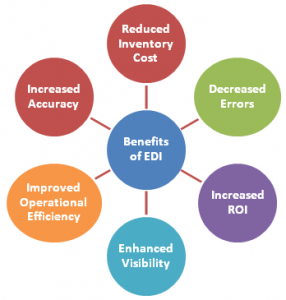Following are the benefits of EDI:-

-
Speed:-
Information moving between computers moves more rapidly and with little or no human intervention. Sending an electronic message across the country takes minutes or less.
-
Improved problem resolution:-
EDI responds quickly to business enquiries and transfers of documents with an automatic audit to ensure accuracy and consistency. EDI can minimize the time companies spend to identify and resolve the inter-business problem as most of such problems come from data-entry errors. Thus, EDI improves the relationships between the trading partners.
-
Streamlines the information flow:-
EDI helps in streamlining of goods, invoice preparation and transmission can all be done within a few hours. This is a significant improvement over the non-EDI environment which takes days\weeks to do the same.
-
Reduces redundancy:-
Often, trading partners file the copies of same document at multiple places. The EDI environment eliminates the need for multiple copies and reduces redundancy without copies and reduces redundancy without compromising the accessibility and retrieval of old documents.
-
Reduces Lead Time:-
As the exchange of documents among trading partners happens electronically through interconnected computers, a lot of time is saved. The process of transferring the documents and information is instantaneous and offers weeks of time saving as compared to the traditional environment that uses postal\courier based exchange of printed documents.
-
Easy retrieval of older documents:-
As all the documents exchanged between trading partners are stored in an electronic mailbox, documents can be accessed, retrieved and examined at any point of time very easily. While, in case of a non-EDI system, if may take hours or even days to locate and retrieve a printed business document from the past.
-
Improvements in overall quality:-
EDI brings improvements in overall quality by providing better record keeping, fewer errors in data, reduction in processing time, less reliance on human interpretation of data, minimized unproductive time.
-
Reduces errors:-
The direct electronic transfer of documents between inter-organizational systems eliminates the chances of errors due to re-entry of data printed on paper from one system to another system.
-
Provides better information for management decision making:-
It provides accurate information and audit trails for transactions, enabling businesses to identify area offering the greatest potential for efficiency improvement and cost reduction.
-
Expands the market reach:-
Most of the large manufacturers deal only with the EDI enabled suppliers. In order to streamline the purchase process, they often form a value-added network. By being a part of that network, many opportunities open up for supplying the material to other suppliers who are also a part of the network.
-
Increases revenue and sales:-
May large organizations use EDI and trade with other EDI-enabled suppliers. The efficiency acquired by EDI reduces the total transaction cost by eliminating paperwork and related errors. It also helps in quicker settlement of accounts. The reduced transaction cost saves money and the supplier is in a better position to offer the items at cheaper costs, which leads to improved revenue and sales.
-
Cost reduction and time-saving:-
By elimination unnecessary paperwork, information flow becomes more efficient. For example the seller’s EDI computer sending electronic billing documents eliminates the paper invoices.
-
Improved customer service:-
EDI can improve customer service by enabling the quick transfer of business documents reducing the errors and by providing an automatic audit trail.
-
Reduces turnaround time:-
Electronic trading documents can be delivered far more quickly than their paper counterparts, thus the turnaround time from order to delivery can be reduced.
-
Accuracy with Integrity:-
Eliminating data entry means improved accuracy in the way data are processed. This contributes to the integrity and reliability of the business processes. The receipt of more accurate and complete business transactions through EDI improved information processing.
-
Planning and forecasting:-
By using EDI for forecasting and planning, companies are able to get forward of likely orders and thus it can plan the production and stock levels accordingly.
-
Accurate invoicing:-
Just like orders, invoices can also be sent electronically. The EDI invoice can be automatically match against the original order and cleared for payment thereby avoiding all sort of queries that arise when paper invoices are matched to order.
The benefits of EDI implementation can also be classified into direct benefits and long term strategic benefits.
Direct Benefits:-
- Data is entered only at the source, thereby decreasing the errors.
- There is no need for rekeying the information as the transfer of information from computer to computer is automatic.
- Cost of processing EDI documents is much less than that of processing the paper document.
- Customer service is improved. The quick transfer of business document allows order to be fulfilled faster.
- There is improved job satisfaction among data entry operators, clerks etc. as they deployed in more creative activities.
- Information is managed more efficiently.
Strategic Benefits:-
- Customer and supplier relation are improved through more effective and faster communication and exchange of information.
- More accurate forecasting and business planning is achieved due to information availability at the right place and right time and with the help of data mining techniques.
- The competitive edge is maintained and enhanced.
- Business relations with trading partners are improved.
- Reduction of paper products is achieved.